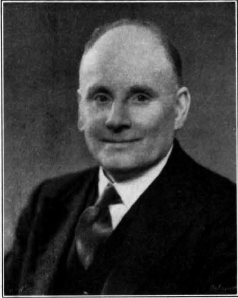Albert Hall (engineer)
Topic: Biography
 From HandWiki - Reading time: 3 min
From HandWiki - Reading time: 3 min
Albert Hall born Portsmouth (1878 – 11 February 1941) was an English engineer and inventor, notable for his contribution to improvements in electricity generation and the development of radio and early radar. He served as an apprentice in the Naval Dockyard and gained a scholarship to study at the Royal College of Science. After graduating he was recommended to Dr Sebastian Ziani de Ferranti by Professor John Perry, which resulted in Hall joining Ferranti in 1902.[1]
Early years
Dr Ferranti was convinced that the future prime mover for electricity generation would be through a turbine engine employing very high temperatures. Hall's experience in thermodynamics was crucial to the development and patenting of materials able to withstand these high temperatures and stresses. Their collaboration eventually resulted in them producing nickel-protected soft steel turbine blades and machinery for their manufacture.[2] Dr Ferranti had already been working for some years with J & P Coats of Paisley on cotton spinning improvements and it was here that Hall developed a small air-lubricated turbine to replace individual spindle motors, increasing the spindle speed from 6000 rpm to more than 20,000 rpm. According to J F Wilson[3] Coats financed this and also agreed to co-finance the turbine development with Vickers of Sheffield, with Hall supervising the main projects[4] while commuting between Paisley and Sheffield.
World War I
In 1915 Hall was requisitioned by Lord Chetwynd to enter the service of the Ministry of Munitions to act as his assistant. Hall was to help design and build the Largest Shell Factory in England for the manufacture of Amatol and the filling of shells and bombs. During his time as chief engineer there, he lived on site in Orchard Cottage and survived a massive explosion, the cause of which was never determined. Hall's work in Chilwell was acknowledged in 2012 when a commemorative plaque was placed on the re-built property.[5]
Return to Ferranti
In 1919 after the war, he returned to Ferranti and also remained in a consulting capacity to Lord Chetwynd and as a technical adviser to the British Mannesmann Tube company. Around 1922 Dr Ferranti became interested in the science of Radio and sound reproduction; it followed that Hall had to become interested too. His knowledge of operational calculus was well suited to dealing with the mathematical equations encountered in that field and allowed him to make the transition into Radio. At that time manufacturers paid royalties for each valve-holder that they fitted to a radio receiver, so they looked for ways to circumnavigate these royalties wherever they could. With this in mind, it also made sense to manufacture radio components for sale to other radio manufacturers and Hall soon became busy with this too. He was instrumental in designing and producing the AF family inter-valve audio frequency transformers[6] for use in radio receivers.[7] He also worked on valve (vacuum tube) development, producing several patents relating to Radio and component manufacture.[8][9][10][11][12][13][14] In order to augment the sales of components to the amateur home constructor, Hall wrote a book[15] that covered mathematical formula, radio-frequency amplification, loud speakers, power supplies and included many practical suggestions. At the annual Olympia Exhibition in 1929, Ferranti unveiled their first radio developed by Hall marketed as The Standard Model 21[3] In 1931 Hall was responsible for employing Kenyon Taylor, who went on to become one of Ferranti's prolific inventors.
Death
During World War II, Ferranti were involved in various aspects of radar development and on 11 February 1941, while travelling to an AA gunnery radar site, Hall and his assistant Gilbert Newbigging were killed when the car they were travelling in collided with an army convoy in thick fog.
References
- ↑ "Obituary Albert Hall". The Engineer: 163. 7 March 1941. http://www.gracesguide.co.uk/images/7/76/Er19410307.pdf. Retrieved 1 February 2015.
- ↑ Intellectual Property Office British Patent GB190401409
- ↑ 3.0 3.1 Ferranti and the British Electrical Industry J F Wilson (P 88) ISBN:0719023696
- ↑ Life and Letters of Sebastian Ziani de Ferranti. G Z de Ferranti and Ince (P179) (Williams & Norgate 1934)
- ↑ "Beeston and District Civic Society"
- ↑ Ferranti Packard: Pioneers in Canadian Electrical Manufacturing Norman R Ball, John N Vardalas (P97) ISBN:0773509836 ISBN:978-0773509832
- ↑ Intellectual Property Office British Patent 1926 GB248429
- ↑ Intellectual Property Office British Patent 1927 GB273484
- ↑ Intellectual Property Office British Patent 1928 GB295414
- ↑ Intellectual Property Office British Patent 1930 GB329689
- ↑ Intellectual Property Office British Patent 1930 GB331541
- ↑ Intellectual Property Office British Patent 1936 GB443956
- ↑ Intellectual Property Office British Patent 1931 CA309505
- ↑ Intellectual Property Office British Patent 1940 GB526621
- ↑ The True Road to Radio Publisher: Ferranti : Hollinwood Eng. : Ferranti; Third Edition (reprint) edition (1932) ASIN: B001OWU6CA
 |
 KSF
KSF
